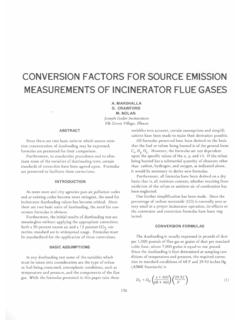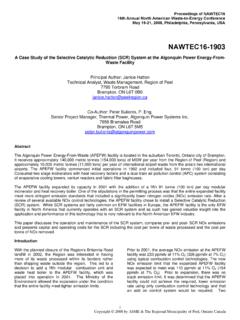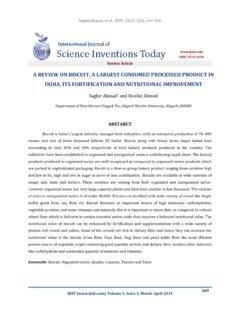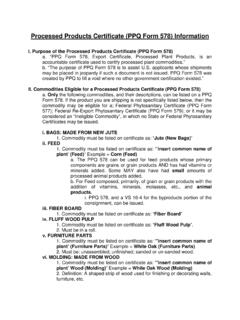Transcription of Processed Engineered Fuels Derived From Paper and Plastics ...
1 Processed Engineered Fuels Derived From Paper and Plastics -- Techno- economic factors and regulatory Issues in a Competitive Market Michael M. Fisher, Director of Technology American Plastics Council, Inc. 1801 K Street, NW, Suite 701-L. Washington, DC 20006. Oscar O. Ohlsson 1014 Thunderbird Lane Naperville, IL 60563. Arun Singhania Amoco Chemical Company 4500 McGinnis Ferry Road Alpharetta, GA 30202. Jose Sosa, FINA Oil and Chemical Company Box 1200. Deer Park, TX 77536. 475. INTRODUCTION. Plastics have gained a prominent position in modem society because their unique properties, cost . performance and versatility. They contribute to almost every aspect of modem life including transportation, recreation, medicine, packaging, appliances, furniture, textiles and building and construction. The diverse properties of Plastics allow them to play a major role in providing solutions for technical progress as well as solutions for everyday life.
2 Plastics also make a significant contribution to effective resource management and conservation, reducing our use of natural resources and helping to minimize waste. By choosing Plastics , manufacturers, designers, distributors and retailers in every sector have been able to respond to the challenge of preventing excess use of resources and, at the same time, bring increasingly sophisticated products to the market. Resource conservation seeks to maximize efficiency and minimize waste from a product's manufacture, use and disposal. It involves more than managing and minimizing waste, however; it also includes taking advantage of effective life-cycle resource management at local and global levels. There are many ways that Plastics contribute to effective resource management. From manufacture to use, to recovery, to waste management, Plastics help conserve resources. Not only are Plastics energy efficient, but they often create less waste than other materials.
3 They can be recovered, recycled and safely landfilled. Plastics play an important role as a potential source of energy. Since they are manufactured from oil and natural gas, Plastics can be viewed as "diverted" energy that is reclaimed in an energy recovery process. Recovering energy from post-consumer Plastics is important for two reasons. First, Plastics contain the highest energy value of any component of the municipal solid waste stream. Second, practical, technical and economic barriers limit the sensible reuse and recycling options of any material. By committing high-energy materials like Plastics to land disposal, a significant energy resource is lost. One objective of the American Plastics Council (APC) is to explore and extend the benefits of Plastics that are not currently being realized and utilized. An important goal is to help ensure that all economic and environmentally responsible recovery options are available for Plastics .
4 By providing information about the environmental and economic impacts, positive and negative, of each municipal solid waste management and resource recovery option, we can make more informed decisions and achieve the goal of effective resource conservation. This Paper reviews the energy recovery option for post-use Plastics . It discusses Plastics ' role in modem waste-to-energy (WTE) systems and then reviews some recent work exploring the use of Plastics as alternative Fuels . The emphasis is on solid Fuels , often referred to as process Engineered fuel or PEF. The liquefaction and gasification of Plastics offers additional opportunities for resource recovery, but this subject is only briefly discussed in this Paper . OVERVIEW. Figure 1 summarizes three basic options for the recovery of energy from post-use Plastics . They are municipal solid waste combustion or waste-to-energy; process Engineered fuel (PEF) Derived from Plastics or combinations of Plastics and Paper ; and liquid or gaseous Fuels Derived from the liquefaction or gasification of post-use Plastics .
5 The end product from all three processes is useful energy. The first option can be categorized as commercial and mature, the second as commercial and embryonic, especially with regard to the use of Plastics ; and the third as developmental. On the basis of these three options and the expanding need for energy worldwide, energy recovery from post-use Plastics is expected to grow as a significant component of integrated resource management. WASTE-TO-ENERGY (MUNICIPAL WASTE COMBUSTION). According to the most recent EPA report on municipal solid waste titled Characterization of Municipal Solid Waste in The United States: 1995 Update, 1 Plastics make up percent by weight ( million tons) of municipal solid waste. On this basis, Plastics contribute almost 30% to the fuel 476. value of MSW. In combination with the non-recycled Paper content of MSW, the combined contribution is more than 50% of the fuel value (Figure 2).
6 The same EPA study found that in the United States, 20% of MSW, after recycling and composting, is combusted--essentially all with energy recovery. The 20% figure is not often cited. The more common convention in the United States is to report the percentage for a given disposal or recovery technology applied to the total of all MSW generated. On this basis, the percent of MSW combusted is about according to both E 1>A and Integrated Waste Services Association (IWSA) It is often unclear on which basis European and Japanese data are being presented. Nevertheless, many countries such as Denmark, Switzerland, and Japan, and some regions of the United States, presently recover the energy from over 50% of generated MSW. Table 1 summarizes information from the Integrated Waste Services Association (Washington, DC) on municipal waste combustion, which confirms that more than 97% of MSW combustion in the United States involves energy recovery.
7 A recent modeling study suggests that there is significant potential for further growth of the waste-to . energy industry in metropolitan areas across the United States under the assumption that the minimum viable resource recovery plant throughput is 400 tons per day of MSW. 3 This was ess ntially a hypothetical landfill diversion study. The study indicated that up to 76% of the population could effectively be served by modern mass burn technology compared to about 16% today. With 76% of the population served, approximately 58% of generated MSW would be managed in waste-to-energy facilities. In practice, of course, marketplace economics are often the controlling factor as to which waste management option is used. The same study examined certain economic assumptions which could impact the viability of WTE in the future. Figure 3 shows a theoretical relationship between the calculated tipping fee which would need to be charged by a newly constructed WTE plant to break-even as a function of electricity sales price (effectively revenue).
8 For comparison, Figure 3 also shows the range of average regional landfill tipping fees across the According to the assumptions of this model, relatively high electricity sales revenues are needed for WTE costs to be competitive with average landfill tipping fees. It is important to note, however, that this model is for new plants and assumes that all of the ash would be landfilled as an expense, rather than beneficially used. As noted above, Plastics provide an important fuel source for the waste-to-energy process. Indeed, in the today, roughly one out of every five pounds of post-use Plastics are used for energy recovery in modern waste-to-energy plants. A recent study in Wiirzburg, Germany involving a mass burn municipal waste combustor equipped with baghouse and carbon injection demonstrated that mixed Plastics in the MSW stream improve burn-out of gases and solid residue without adversely affecting ash or emissions.
9 4. As plastic loadings were increased during the tests, CO and S02 emissions were reduced. In addition, higher polymer content, including specific addition of polyvinyl chloride, did not result in an increase in dioxins and furans. This finding supports the general conclusion of a recent ASME study that dioxin emissions from modern waste-to-energy plants do not correlate statistically with the quantity of chlorine in the feed. 5 In fact, both the findings of the Wiirzburg study and the International Ash Working Group Report 6 indicate that modern waste-to-energy plants are a net destroyer of dioxins. Today, waste-to-energy technology is playing an important role in utilizing the energy content of Plastics and other polymeric materials, and there are additional opportunities for the future. Recently, APC completed a study to assess the energy recovery option for automotive shredder residue, the byproduct of the automobile shredding operation.
10 7 The energy content of ASR ranges from about 4000. to 1 1,000 Btullb depending on the degree of processing. The study looked at mass burn technology, RDF, industrial boilers, cement kilns, and emerging gasification technologies, and concluded that co . firing ASR with MSW in a modern mass burn waste-to-energy plant offered the most practical means to capture the inherent energy of this material. 477. PROCESS Engineered fuel . Basic Definition Process Engineered fuel (PEF) can be defined as a Processed solid fuel , made from segregated plastic and Paper , Derived from industrial, commercial, and residential sources, for use by utilities and industry. 8 The term Paper is used broadly to refer to a wide variety of non-recyclable Paper , boxboard, corrugated, and other cellulosic-based feedstocks. Plastic feedstocks can be in rigid, foam, or film form . Figure 4 shows the sourcing options, fuel processing step, and markets for PEF.

















